 |
Articles
12 Apr 2011 Space & CAD in Russia: 50 Years since Gagarin FlightVladimir Malukh Today we are celebrating the jubilee of perhaps one of the most outstanding technical achievements in the history of mankind – the first man flight to the space. Those 108 minutes forever made it into the history, and the famous smile of Yuri Gagarin has become probably the most recognisable symbol of Russia.
 In just a few hours these two people would be the happiest ones on the whole planet,
but at the moment the picture was taken hardly anybody could be more worried.
In just a few hours these two people would be the happiest ones on the whole planet,
but at the moment the picture was taken hardly anybody could be more worried.
Rocket and space technology has always been on the cutting edge of technological progress; however, back in 1961 developers of “Vostok” could not use CAD because such tools simply did not exist – the first CAD prototype, as we understand it now, appeared only in 1963. Russian Principal Designer. Sergey Korolyov, and his colleagues used traditional engineering tools for that period – a drawing board and a slide rule.
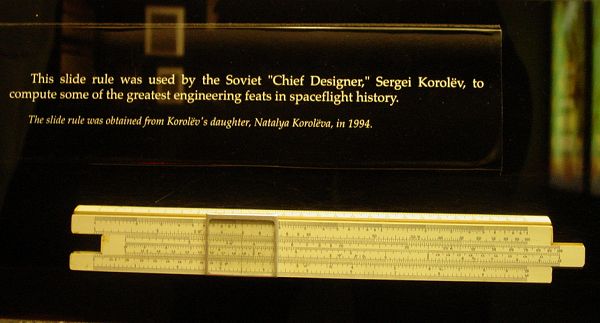 The slide rule of Sergey Korolyov on display in the Cosmosphere, Hutchinson, Kansas
The slide rule of Sergey Korolyov on display in the Cosmosphere, Hutchinson, Kansas
Time moves on and half a century later the successors of Yuri Gagarin and the designers of the legendary “Rocket 7” that put the first sputnik and the first dog named Laika to the orbit widely use modern design technologies. Unfortunately most companies in the space industry traditionally tend to preserve their closed nature and are reluctant to share information. So we are particularly pleased that there are companies prepared to share some of their experience with a wide range of colleagues. First of all, we mean the “Progress” Space Centre of Samara.
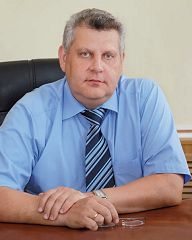 Nearly a year ago a series of events were organised throughout Russia as part of PTC Innovation Forum’10. One of the workshops involved Alexander Philatov, the Head of the IT Department of “Progress” Samara Space Centre - the company that for over fifty years has been producing legendary launch-rockets, originating from R-7: “Vostok”, “Voskhod”, “Molnia”, “Soyuz” - that Russian cosmonauts used to fly and that delivered automatic stations to the Moon and other planets. Alexander Philatov told us how introduction of modern technologies can improve efficiency by reducing development time and costs and enhancing the product quality. Effectively there is no moulding loft in production lines at “Progress” – everything works on the basis of 3D models – from master-geometry to specific mock-up workpieces.
Nearly a year ago a series of events were organised throughout Russia as part of PTC Innovation Forum’10. One of the workshops involved Alexander Philatov, the Head of the IT Department of “Progress” Samara Space Centre - the company that for over fifty years has been producing legendary launch-rockets, originating from R-7: “Vostok”, “Voskhod”, “Molnia”, “Soyuz” - that Russian cosmonauts used to fly and that delivered automatic stations to the Moon and other planets. Alexander Philatov told us how introduction of modern technologies can improve efficiency by reducing development time and costs and enhancing the product quality. Effectively there is no moulding loft in production lines at “Progress” – everything works on the basis of 3D models – from master-geometry to specific mock-up workpieces.
At “Progress” they srlected their system very carefully. Initially “Progress” selected three solutions based on high-¬end systems and developed by the key players on the global CAD/CAM-market: Pro/ENGINEER (now known under the brand of Creo Elements/Pro), NX (at that time – Unigraphics) and CATIA. Before the competitive design all three systems had practically equal chances to win. None of them had been used earlier at the plant so there were neither pilot projects, nor trained personnel that in combination could have affected the “Progress” choice.
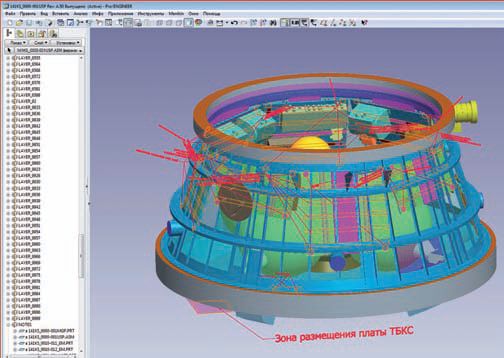 “Volga”insertion block: protectant’s control structure
“Volga”insertion block: protectant’s control structure
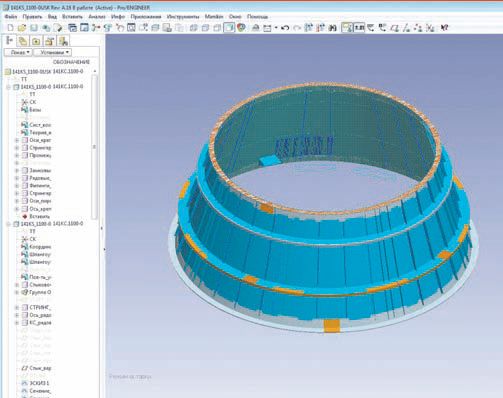 Design engineer’s control structure
Design engineer’s control structure
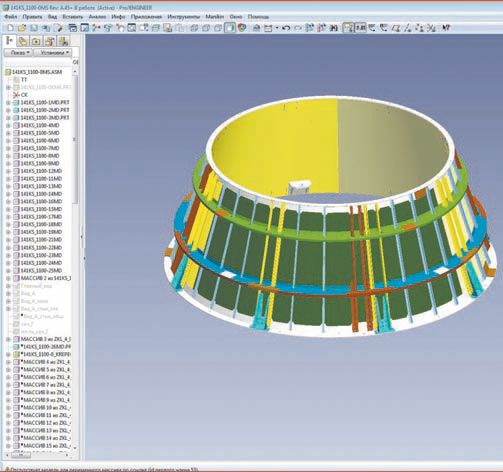 Drawing office assembly
Drawing office assembly
Participants were given a rather complex component to be milled. They were supposed to optimize the construct, develop its digital mock-up and obtain NC data for a particular machine unit. Based on a number of factors, representatives of Pro/ENGINEER and Unigraphics were able to complete the task best. Other key figures being close, the final choice in favour of Pro/ ENGINEER was influenced by the costs of the solution. The price of the standard package of its nearest competitor was considerably (manifold) higher, and due to budgetary constraints the company could not afford buying the most expensive products. Thus, the victory of Pro/ENGINEER was univocal.
Answering a question why “Progress” decided to enter in cooperation with a foreign company rather than one of Russian ÑÀÏÐ/PLM developers, Alexander Philatov explained:
- It seems that it is still difficult for Russian CAD developers to compete at equal terms with the global leaders in development of “hard” CAD and PDM systems. And time presses. As we operate not only on domestic market but also on the global market, the company must keep up to the latest standards. However, I sincerely believe that the time of Russian top-class CAD will come. And it’s just around the corner.
It does not mean, however, that “Progress” only uses foreing solutions. In fact combination of Pro/ENGINEER and Windchill focuses mainly on developing the most technologically complex products – launcher rockets. “Progress” also develops spacecrafts, production tools, aviation equipment and consumer goods.
The company also has AutoCAD and SolidWorks licenses that are applied to find solutions to particular tasks. They have their own niche, and it does not cause any problems. ASCON software (LOTSMAN:PLM, KOMPAS, VERTICAL) is a special subject. ASCON actively develops its software line, which today is competitive with other mid-level solutions. “Progress” Space Centre has used and continues using ASCON software products. Some projects are fully KOMPAS-based and it makes no sense to transfer them to Pro/ENGINEER. Furthermore, “Progress” IT experts have succeeded in integrating VERTICAL, Windchill and ASUP (in-house enterprise resource management system) for process planning and production scheduling. This combination is being developed and actively implemented within the company.
Nevertheless, “Progress” still uses Russian solitons widely, especially for process planning, where ASCON-developed VERTICAL is used extensively. Moreover – “Progress” managed to integrate VERTICAL, Winchill and corprorate ERP system.
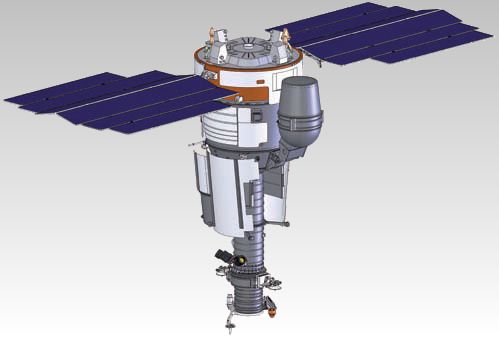 Digital Mock-up of “Resurs-DK1” Spacecraft made in KOMPAS-3D
Digital Mock-up of “Resurs-DK1” Spacecraft made in KOMPAS-3D
Currently the company most widely uses both KOMPAS and CAD developed by ÐÒÑ. The use of AutoCAD is limited to development of electrical schematics, interconnecting cables and design documentation for cables. This refers to “SAPR KS” where the platform is AutoCAD. “SAPR KS” is still in use as implementing Pro/ENGINEER - RSD and Cabling modules experiences certain difficulties. Generally, according to Mr. Philatov, product cabling, developing and testing their electrical schematics – is one of the most complex tasks. The process involves multiple experts in various fields, and the company has design and technology specifics, which standard solutions may not fit right away. Jointly with “Productive Technological Systems” (PTS Ltd.), experts of “Progress” work on adjusting and adapting Pro/ENGINEER modules for these tasks and the first results have already been achieved.
Older designers evidently resisted when the use of AutoCAD was limited. They mastered the package 15 and more years ago and today at the age over 60 it is extremely difficult for them to learn how to use a different system. Under those circumstances, the best option for those designers was to master KOMPAS for preparing design documentation, and this decision proved to be absolutely correct. Implementing the above projects, components that should be processed by NC equipment are modelled in Pro/ENGINEER, and Pro/ENGINEER is also used to develop NC data for NC machine tools.
Currently the company has bought around 200 network licenses for PTS software products, including standard Pro/ENGINEER packages, advanced assembly modules (Àdvanced Assembly Extension), and dimension chain modules as well as RSD, Piping and Cabling. The company also acquired 8 full-featured Pro/ENGINEER Flex 3C. All licenses are located on the central server and are accessible (on a competitive basis) from the working stations, where the necessary distributives are installed. Additional software can be bought when problems arise with users' access to the licenses.
Each year, starting from 2005, the company has been increasing the number of licenses stage-by-stage to reach the required level. This work will continue until there is a demand for it. A PDM-system Windchill has a very beneficial licensing scheme, so “Progress” has not experienced any issues with lack of connections or installations: there are as many as it is necessary. Currently more than 450 people work with Pro/ENGINEER and the company puts efforts that they all also master Windchill. Users of Windchill include protectants, designers, and manufacturing engineers, experts of the Technical Office,\ and the Regulatory Information Office, and now executive officers at different levels.
- What we could not put up with were the unnecessary extended project implementation periods. New time and conditions require us to increase our competitive ability, and shorten the lead time. Now let’s get to the issue what we must break with and forget. My opinion – there is no need to break anything. We must understand the processes, have a good grasp of them. The company is functioning, has good workload indicators and cannot stop to implement certain processes and system. There is simply no time for this. Our objective is to bring new technologies to the existing processes and achieve a smooth and painless transition to these new technologies. Everything that will become unnecessary after this, will become extinct by itself, says Alexander Philatov.
“Progress” Space Centre has developed a unique method of top-down design, which comprises all rules and principles of project work. According to Mr. Philatov, without this method the company was lacking a fundamental approach. “Progress” members of staff had long been working on this document together with “PTS” Ltd. Overall it took around two years to complete the document. The methodology is approved by the company leadership and it is foundational. At the same time it has been improving continuously. As a result, within just a year the company was able to complete the full cycle of works towards developing a new light-class launcher-rocket “Soyuz-2”: from a concept design to a 3D model, technical documentation and starting industrial production. Typically it takes six or seven years. “Soyuz-2” is a new launcher-rocket, which in the future will allow replacing “Soyuz-U”, “Soyuz-FG” and “Molnia-M” launcher-rockets with a single launcher-rocket. At the moment the rocket is undergoing flight tests started in 2004.
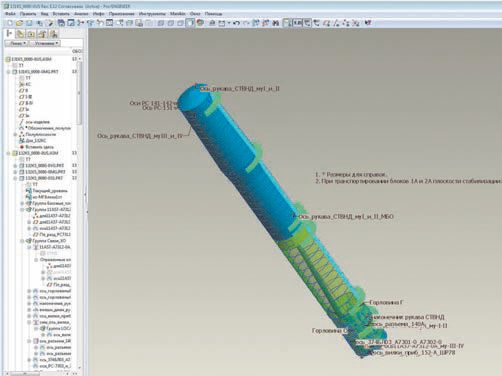 “Soyuz-1” launcher-rocket: protectant’s control structure
“Soyuz-1” launcher-rocket: protectant’s control structure
“Progress” experience in training and retaining experts for working with such a complex and advanced system as Pro/ENGINEER is undoubtedly very interesting. When new technologies arrived to the company, the issue of technical training was urgent. The first thing that the company did was organising two in-house training classes with all necessary equipment. The Department for Technical Training forms training groups, concludes contracts with tutors and controls the quality of training as well as students’ attitude to training.
Experts of “PTS” Ltd. teach how to work with PTS products. Courses are arranged to meet specific project requirements and the needs of particular units of the company. At “Progress” they justly believe that the right approach is when training is provided by the consulting firm although the company already has its own specialists who have mastered the products. It is essential that in course of training all trainees learn to work according to the unified rules as the final outcome depends on the work of each of them. More than 200 members of staff from different units have already completed the training and most of them have attended two or three courses. The fact of the matter is that basic knowledge about Pro/ENGINEER is not enough for efficient work – one must also master for top-down design, etc. The actual number of Pro/ENGINEER users is much higher because young professionals can study the system independently, graduates join the company being already partially trained and in some areas specialists from the CAD Department organise training themselves.
- Certainly, working with young people is easier; they grasp everything new in a single flash. However, young people lack experience and necessary, – says Alexander Philatov. Therefore we work with all groups and we do not break anybody. Sometimes we face resistance but the method of persuasion suffices. When a first-rate designer who has been working with the company 25÷30 years and sometimes even longer, masters such a powerful tool as Pro/ENGINEER, the effect is overwhelming. And what is the most important – it’s an example for others. There are specialists who mastered computer technologies at the age of 65 or 70 and they are doing perfectly OK. As the saying goes, where there is a will there is a way.
“Progress” is actively involved in cooperation with Samara State Aerospace University named after academician Sergey Korolyov. The best graduates stay with the company. Furthermore, the University now has a specialisation directly oriented to “Progress” Space Centre – automated product lifecycle management. First students graduated in 2009 and many of them are now full-time employees of the company. Students are encouraged to work part-time so when graduated they can promptly immerse in work. The IT Department also employes students of the two final years, that are eager to learn about the processes within the company and receive professional training.
One of the examples of student projects is developing “AIST” small student spacecraft. Design and engineering technology of a small spacecraft was fully based on CAE/CAD/CAM systems, it included the full cycle of designing separate space-borne systems, satellite engineering in general, and production implementation of engineering documentation and its operational support.
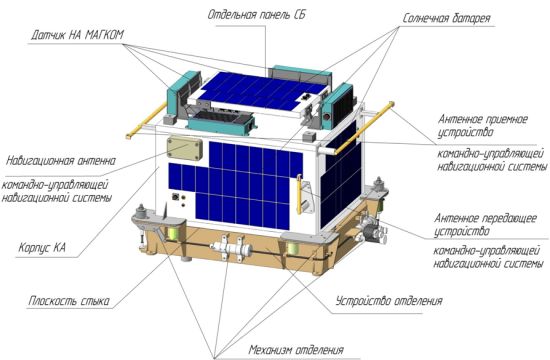 General view of “AIST” small spacecraft
General view of “AIST” small spacecraft
To design spacecraft components that need NC machining, students used Pro/ENGINEER, storing data in Windchill, and the processes of manufacturing the small spacecraft were designed in VERTICAL, using a Universal Engineering Manual. Designed processes were saved in LOTSMAN:PLM as an object model linked to the product (the small spacecraft). The object approach enables to account for the main and auxilliary materials, fixtures, equipment, tools, etc., and compile timely engineering reports based on the LTSMAN:PLM data. Therefore, already at the student level the future rocket designers are able to master the full cycle of development and production of complex aerospace products according to the standards of a specialised company.
Conclusion
As we see, the rocket-and-space industry maintains its reputation as the top performer in mastering, implementing and effectively using the cutting-edge technologies, including computer-assisted design and production planning. Employment of state-of-the-art CAD is instrumental for successful development of new, more efficient products. Industry veterans are followed by young professionals who study innovative technologies while still being students. We would like to send our compliments to all of them with regard to the anniversary of the historic flight of Yuri Gagarin and wish it remains the same industry that we have been so proud of for over half of a century. Congratulations!
The paper is based on a report prepared by the Head of the IT Department of “Progress Space Centre” Alexander Philatov for PTS Innovation Forum 2010, his interview to the CAD/CAM/CAE Observer, provided by the Office of PTC in Russia, and a report of Mr. Safronov at Samara State Aerospace University named after Sergey Korolyov.
See also:
Permanent link :: http://isicad.net/articles.php?article_num=14348

|
 |